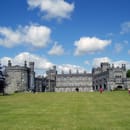Language is continuing to evolve every day. Nowhere is that more evident than the vocabulary used to describe the LGBTQ+ community and the plethora of identities contained within it. It’s important to examine these changes, why they occurred and why they will continue to do so.
Even the acronym (LGBTQ+) is subject to much debate. Tired comedians with no new material love to call it an alphabet soup. For the most part though, LGBT is by far the most commonly used acronym to describe the community. And what those four terms entail is fairly well understood by the general public – those terms being lesbian, gay, bisexual and transgender. It’s everything after that which appears to cause so much confusion.
The acronym has been expanded in an attempt to be more inclusive – the entirety of divergent sexualities and gender can’t fit in four letters. Ultimately there is no number of letters that they’ll ever all fit under. But certain acronyms come closer than others to encapsulating every identity. LGBTQ+ has become increasingly popular in the last few years for this very reason. Q being short for queer and the plus symbol being used to denote that there are other identities not covered within those five letters.
Queer is slightly complicated though. It is a true representation of the metamorphosis certain words can experience. For much of the 1900s, queer was an insult used in a variety of ways – but mainly to insult people who didn’t conform to sexual and gender roles. Because of this history, many members of the LGBTQ+ community actively dislike the word and would rather not be identified as such.
But similarly there are a plethora of (mainly younger) people who self-identify as queer. Why is that? Some find comfort in its ambiguity. Queer doesn’t really mean much beyond not totally straight and/or cisgender (cisgender being the opposite of transgender). As such it allows people to explore their sexuality or gender without having to associate themselves with the baggage of other terms.
The term queer – like the community – is very versatile. Maybe someone doesn’t want to have to explain their identity beyond different than the norm – queer does exactly that. However it should be stated that due to its history as a slur, straight, cisgender people should generally avoid using it. Particularly to describe the community as a whole – LGBTQ+ is a much safer bet.
Similarly, non-binary is often used to describe a variety of identities. Someone who is non-binary isn’t solely one of the binary genders – those being male and female. Instead they may be some combination of the two or exist completely outside of our traditional understanding of gender. There are a variety of terms which fall under the non-binary umbrella – but similar to queer, non-binary can also be an identity in of itself.
DCU student Avery Ildefonse is non-binary and they define it for themselves as “mostly by not relating (at all or partially) of the binary gender”. They use non-binary rather than another term because “it’s a good mix between finding a label that I’m comfortable [with] and how broad the term [is] because I’m still trying to pinpoint some aspects of my own gender”.
There are non-binary people who would label themselves as trans, but not all do. The takeaway from this article should be that everyone is an individual and if you want to best understand them, then just ask. Of course be conscious of the fact that they may be tired of constantly having to explain themselves – so choose an appropriate time and place to do so.
Be aware how asking them how they identify in certain spaces is basically the same as asking them to out themselves. Always keep an open mind and never start to think you’re finished learning.



